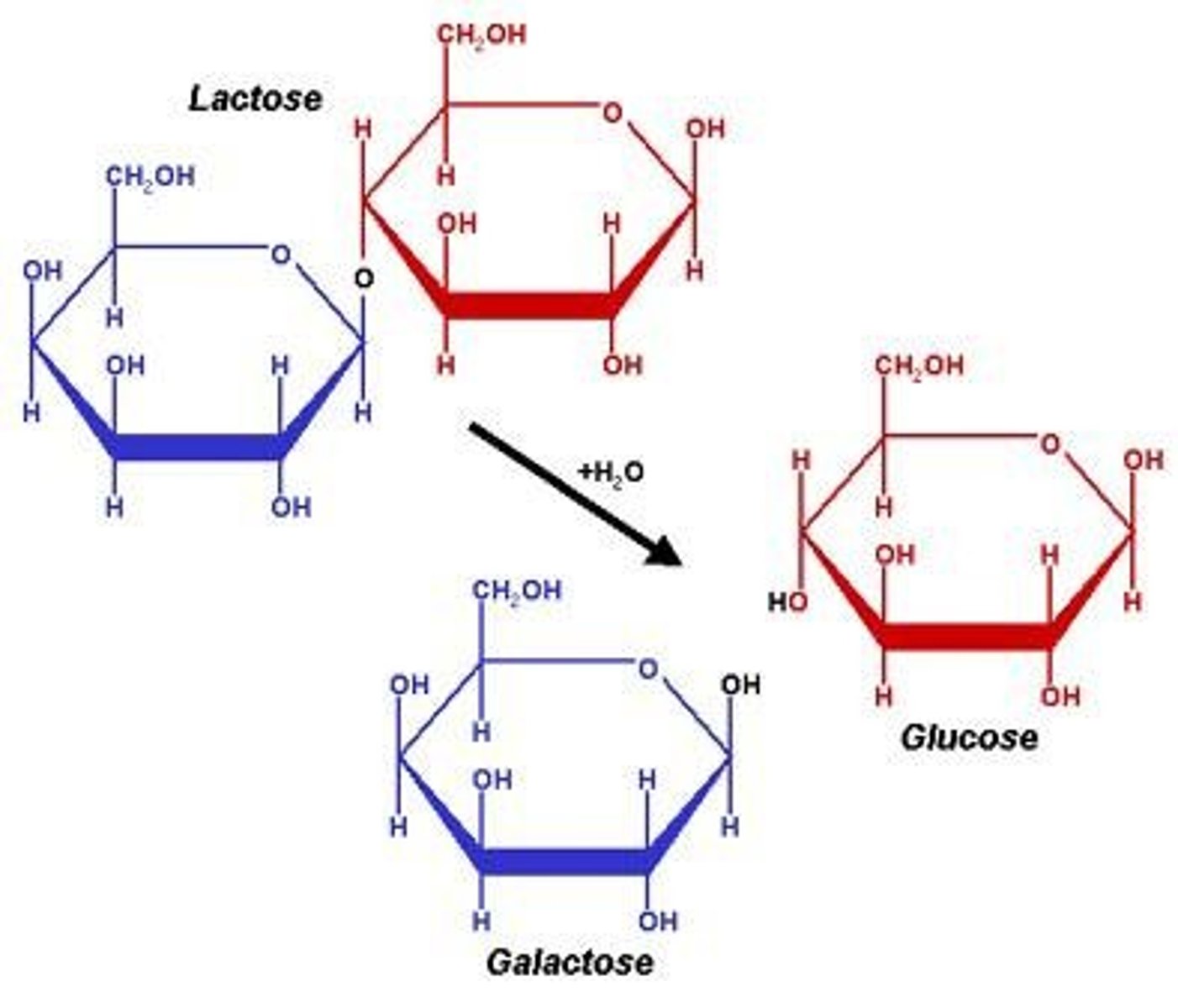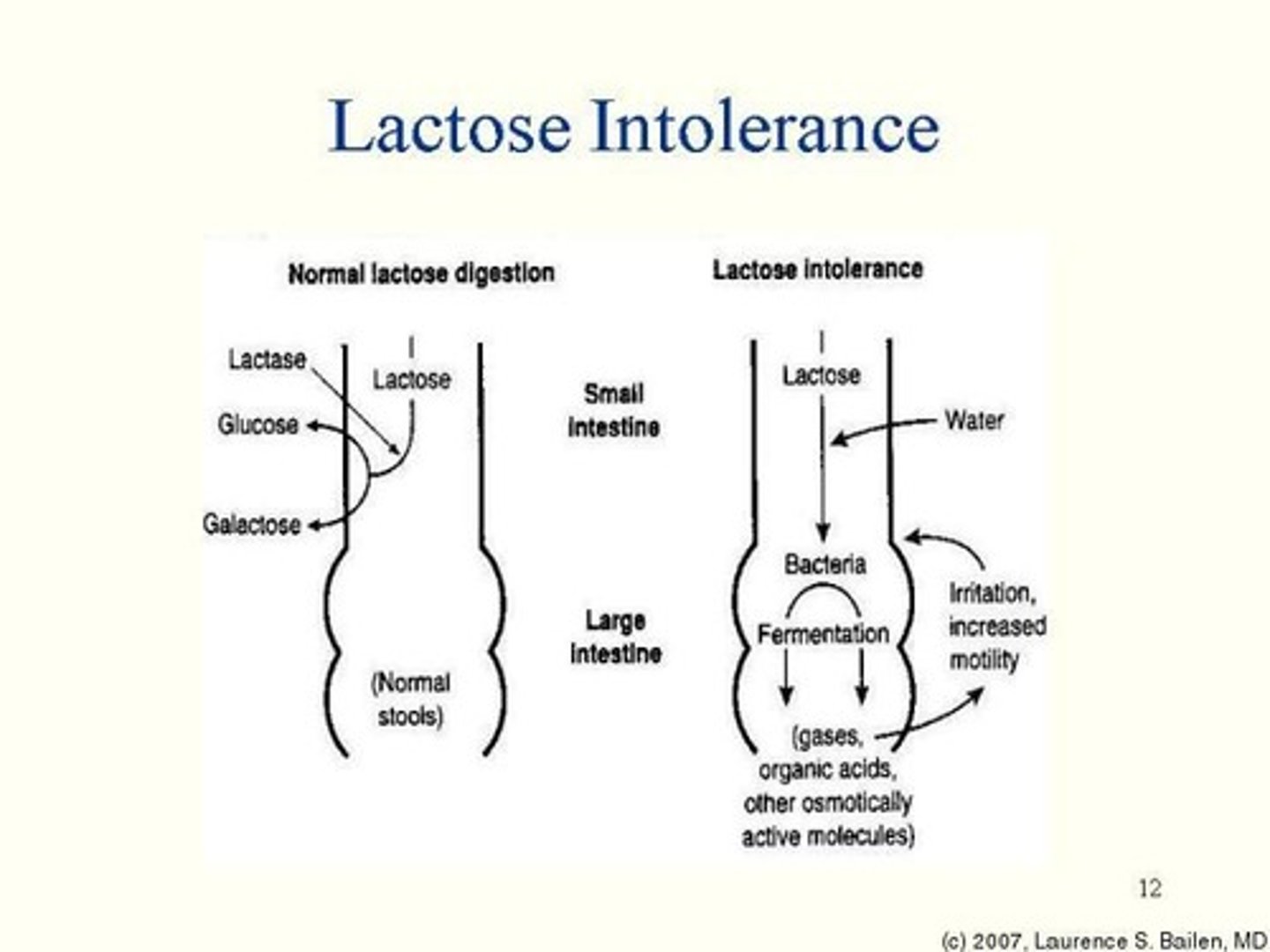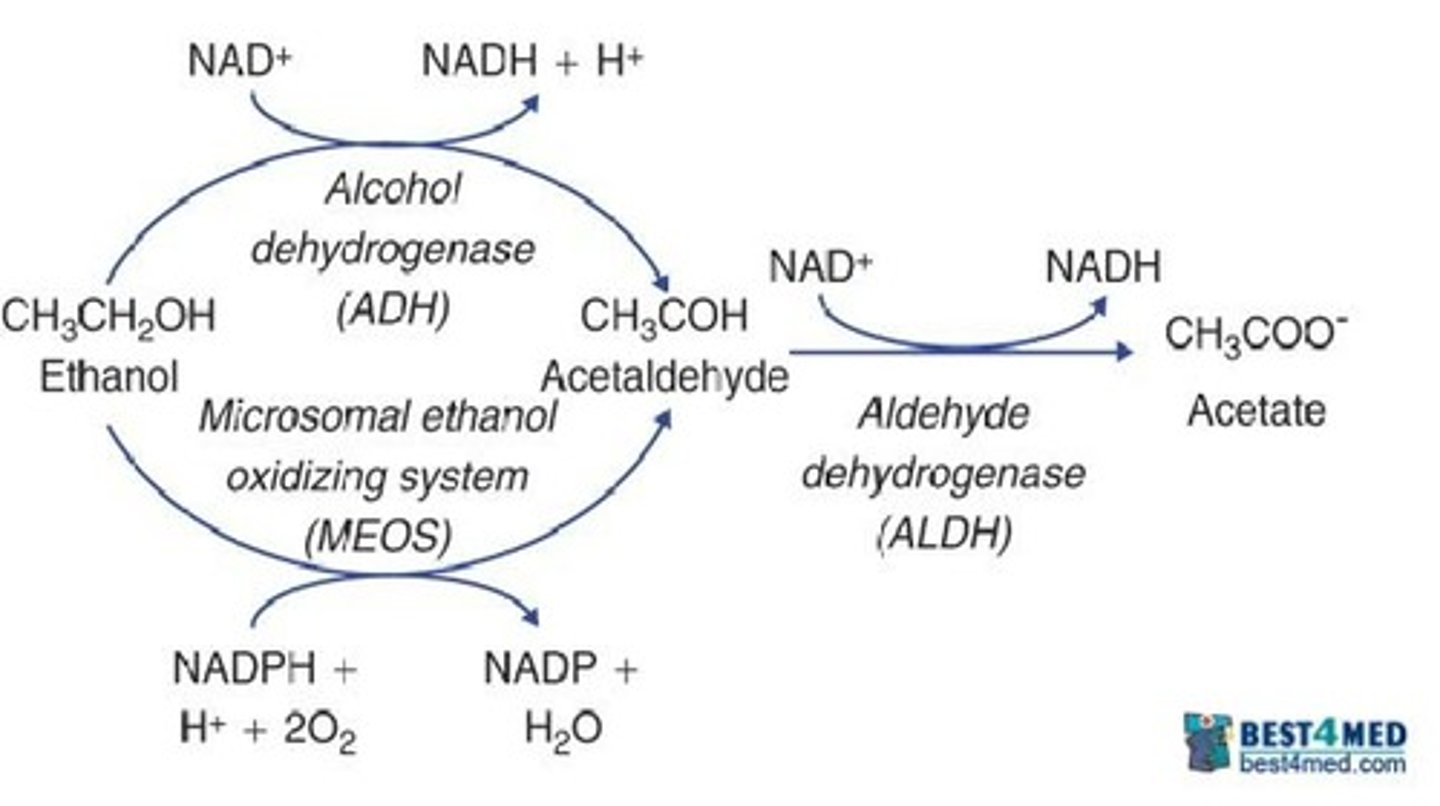Gene-Culture Coevolution of Lactase Persistence and Alcohol Metabolism in Humans
1/52
There's no tags or description
Looks like no tags are added yet.
Name | Mastery | Learn | Test | Matching | Spaced |
|---|
No study sessions yet.
53 Terms
Lactose
Milk sugar lactose - prime source of carbohydrates for all young mammals, including human infants.
Lactase
β-galactosidase that hydrolyzes lactose.

Lactase non-persistence
In most populations, the ability to digest lactose ceases in childhood, leading to adults being lactose intolerant.
Effects of lactose intolerance
Lactose fermented by bacteria in the colon produces gases such as CO2, methane, hydrogen, and osmotically attracts fluid into the bowel lumen, causing diarrhea.

Lactase persistence
Genetically programmed continued activity of the lactase enzyme into adulthood.
Lactase persistent phenotype
Only needs to receive one copy of the high lactase-activity allele (mutant allele) from their parents.
Lactase nonpersistent phenotype
Is homozygous and received two copies of the low lactase-activity allele (the ancestral allele) from their parents.
Lactase persistence gene variants
The trait arose independently worldwide several thousand years ago, with different mutations producing the same phenotype.
Lactose tolerance
The prevalence of lactose tolerance is highest in populations with a long history of consuming milk products.
Gene-culture coevolution hypothesis
The lactase persistence mutation occurred and became fixed in the population at high frequencies due to pastoralism spreading.
Bacterial fermentation of milk products
Evidence shows that fermented milk products (e.g., yogurt, cheese) have been produced since around 10,000 BCE.
Lactic acid bacteria
Ferment lactose to produce lactic acid, allowing individuals who lack the allele for lactase persistence to still tolerate dairy products.
Selective advantage of lactase persistence
The allele provided a selective advantage and was fixed in the population due to pastoralism.
Pastoralism
The practice of herding and breeding livestock, which influenced the prevalence of lactase persistence.
Mutant vs Non-mutant
A mutant can drink a glass of milk (240 ml) without any unpleasant side effects, while a non-mutant experiences unpleasant side effects.
Timeframe of lactase persistence
Lactase persistence likely only reached appreciable levels in some populations in the last 10,000 years.
Fermented dairy products
Individuals may lack the allele for lactase persistence but can still tolerate dairy products in which lactose is broken down.
Historical significance of dairy consumption
Populations practicing pastoralism developed a higher prevalence of lactase persistence due to their reliance on milk products.
Calcium
An important mineral for skeletal integrity, with over 99% of body calcium present as calcium hydroxyapatite (Ca10[PO4]6[OH]2) in bones and teeth.
Bioavailability of calcium
An important factor to consider beyond simply the calcium content of food.
Vitamin D
Increases calcium absorption in the small intestine, increases calcium reabsorption in the kidney, and increases bone mineralization.
Protein
An essential nutrient for skeletal integrity.
Milk
A relatively clean liquid compared to contaminated water, containing multiple nutrients such as Vitamins A, D, B12, riboflavin, calcium, and phosphorus.
Ethanol [EtOH]
Also known as ethyl alcohol or drinking alcohol, produced by the fermentation of fruit sugars by yeasts.
Ethanol as a toxin
A central nervous system depressant.
History of human ethanol consumption
Humans have been consuming fermented fruit for hundreds of thousands of years.
Gene mutation in apes
Occurred 4 million years ago, allowing apes to digest fermented fruit without severe ethanol intoxication.
Alcoholic beverages production
Independently fermented from many plants containing starch or sugar, with evidence of production in China at least 9,000 years ago.
Alcohol consumption statistics
1 in 25 deaths globally is linked to alcohol consumption, with men five times more likely to die from alcohol-related illness than women.
Alcohol-attributable deaths in Europe
1 in 10 deaths in Europe is directly attributable to alcohol consumption.
Key liver enzymes in alcohol metabolism
Alcohol dehydrogenase (ADH) and aldehyde dehydrogenase (ALDH) are involved in ethanol metabolism.

ADH function
Catalyzes the oxidation of ethanol into acetaldehyde.
ALDH function
Oxidizes acetaldehyde to non-toxic acetate (acetic acid).
Ethanol Metabolism
Steps in oxidation of alcohol: 1. Ethanol ---> Acetaldehyde 2. Acetaldehyde ---> Acetate 3. Acetate ----> Carbon Dioxide + Water
Alcohol Intolerance
A condition where individuals experience adverse reactions to alcohol consumption.
Genic Polymorphisms
New gene variants arise and spread across populations if they have a reproductive advantage.
Alcohol Addiction Protection
Genetic polymorphisms in ADH and ALDH may protect against alcoholism.
ALDH Variants
ALDH variants may protect against alcoholism in East Asia.
ADH Variants
Variants of ADH may protect against alcoholism in Asia and Africa.
ALDH2 Variant
Reduction in the capacity of acetaldehyde clearance leads to accumulation of acetaldehyde in circulation.
ALDH2 Variant Prevalence
Prevalent among northeastern Asian populations (China, Taiwan, Japan, Korea).
Asian Alcohol Flushing Syndrome
Causes facial flushing, tachycardia, nausea, and unpleasant feelings when alcohol is consumed.
Alcohol Flushing Deterrent
Alcohol flushing and its associated unpleasant feelings due to acetaldehyde accumulation is often a strong deterrent against heavy drinking - especially for homozygotes.
Asian Flush
Flushing on the back, characterized by red flushes or blotches on the face, neck, shoulders after consuming alcoholic beverages.
Alcohol Flush Reaction
Due to an accumulation of acetaldehyde in ALDH-deficient individuals.
Disease Risk
ALDH2 deficient populations may be more susceptible to the carcinogenic effect of consuming alcoholic beverages.
Esophageal Cancer Risk
Most evidence coming from studies of esophageal cancer and head and neck cancer.
Tolerance Development
Heterozygotes can develop tolerance to acetaldehyde and the flushing response and can become habitual heavy drinkers.
Cultural Drinking Norms
In Korea, Japan, and China, it is important, especially for men, to socialize and drink heavily.
Economic Growth and Alcohol Consumption
Economic growth and increasing social openness in China over the last 30 years have increased alcohol consumption.
Genetic Evolution
Humans may be evolving genetic variants to make them physically unable to consume large amounts of alcohol.
Atypical ALDH2 Allele
Offers some protection against alcohol dependence and the risk of alcohol-related cancers and accidents.
Cultural Factors in Drinking
Cultural, social and religious factors along with genetics determine if heavy drinking is acceptable.